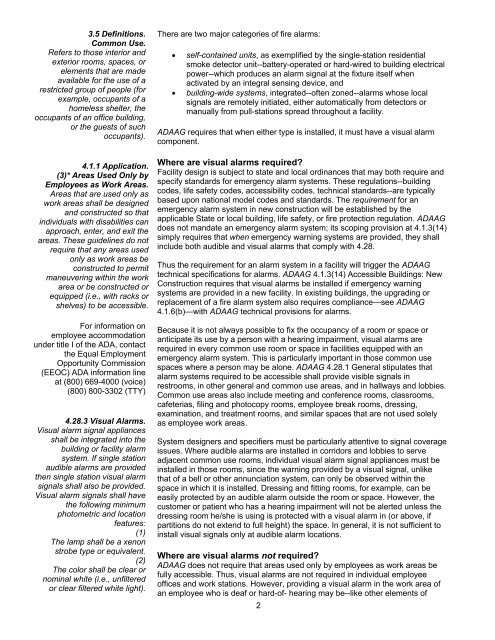Fire Protection Design Manual - Office of Construction and Facilities ...
Fire Protection Design Manual - Office of Construction and Facilities ...
Fire Protection Design Manual - Office of Construction and Facilities ...
Create successful ePaper yourself
Turn your PDF publications into a flip-book with our unique Google optimized e-Paper software.
3.5 Definitions.<br />
Common Use.<br />
Refers to those interior <strong>and</strong><br />
exterior rooms, spaces, or<br />
elements that are made<br />
available for the use <strong>of</strong> a<br />
restricted group <strong>of</strong> people (for<br />
example, occupants <strong>of</strong> a<br />
homeless shelter, the<br />
occupants <strong>of</strong> an <strong>of</strong>fice building,<br />
or the guests <strong>of</strong> such<br />
occupants).<br />
4.1.1 Application.<br />
(3)* Areas Used Only by<br />
Employees as Work Areas.<br />
Areas that are used only as<br />
work areas shall be designed<br />
<strong>and</strong> constructed so that<br />
individuals with disabilities can<br />
approach, enter, <strong>and</strong> exit the<br />
areas. These guidelines do not<br />
require that any areas used<br />
only as work areas be<br />
constructed to permit<br />
maneuvering within the work<br />
area or be constructed or<br />
equipped (i.e., with racks or<br />
shelves) to be accessible.<br />
For information on<br />
employee accommodation<br />
under title I <strong>of</strong> the ADA, contact<br />
the Equal Employment<br />
Opportunity Commission<br />
(EEOC) ADA information line<br />
at (800) 669-4000 (voice)<br />
(800) 800-3302 (TTY)<br />
4.28.3 Visual Alarms.<br />
Visual alarm signal appliances<br />
shall be integrated into the<br />
building or facility alarm<br />
system. If single station<br />
audible alarms are provided<br />
then single station visual alarm<br />
signals shall also be provided.<br />
Visual alarm signals shall have<br />
the following minimum<br />
photometric <strong>and</strong> location<br />
features:<br />
(1)<br />
The lamp shall be a xenon<br />
strobe type or equivalent.<br />
(2)<br />
The color shall be clear or<br />
nominal white (i.e., unfiltered<br />
or clear filtered white light).<br />
There are two major categories <strong>of</strong> fire alarms:<br />
• self-contained units, as exemplified by the single-station residential<br />
smoke detector unit--battery-operated or hard-wired to building electrical<br />
power--which produces an alarm signal at the fixture itself when<br />
activated by an integral sensing device, <strong>and</strong><br />
• building-wide systems, integrated--<strong>of</strong>ten zoned--alarms whose local<br />
signals are remotely initiated, either automatically from detectors or<br />
manually from pull-stations spread throughout a facility.<br />
ADAAG requires that when either type is installed, it must have a visual alarm<br />
component.<br />
Where are visual alarms required?<br />
Facility design is subject to state <strong>and</strong> local ordinances that may both require <strong>and</strong><br />
specify st<strong>and</strong>ards for emergency alarm systems. These regulations--building<br />
codes, life safety codes, accessibility codes, technical st<strong>and</strong>ards--are typically<br />
based upon national model codes <strong>and</strong> st<strong>and</strong>ards. The requirement for an<br />
emergency alarm system in new construction will be established by the<br />
applicable State or local building, life safety, or fire protection regulation. ADAAG<br />
does not m<strong>and</strong>ate an emergency alarm system; its scoping provision at 4.1.3(14)<br />
simply requires that when emergency warning systems are provided, they shall<br />
include both audible <strong>and</strong> visual alarms that comply with 4.28.<br />
Thus the requirement for an alarm system in a facility will trigger the ADAAG<br />
technical specifications for alarms. ADAAG 4.1.3(14) Accessible Buildings: New<br />
<strong>Construction</strong> requires that visual alarms be installed if emergency warning<br />
systems are provided in a new facility. In existing buildings, the upgrading or<br />
replacement <strong>of</strong> a fire alarm system also requires compliance—see ADAAG<br />
4.1.6(b)—with ADAAG technical provisions for alarms.<br />
Because it is not always possible to fix the occupancy <strong>of</strong> a room or space or<br />
anticipate its use by a person with a hearing impairment, visual alarms are<br />
required in every common use room or space in facilities equipped with an<br />
emergency alarm system. This is particularly important in those common use<br />
spaces where a person may be alone. ADAAG 4.28.1 General stipulates that<br />
alarm systems required to be accessible shall provide visible signals in<br />
restrooms, in other general <strong>and</strong> common use areas, <strong>and</strong> in hallways <strong>and</strong> lobbies.<br />
Common use areas also include meeting <strong>and</strong> conference rooms, classrooms,<br />
cafeterias, filing <strong>and</strong> photocopy rooms, employee break rooms, dressing,<br />
examination, <strong>and</strong> treatment rooms, <strong>and</strong> similar spaces that are not used solely<br />
as employee work areas.<br />
System designers <strong>and</strong> specifiers must be particularly attentive to signal coverage<br />
issues. Where audible alarms are installed in corridors <strong>and</strong> lobbies to serve<br />
adjacent common use rooms, individual visual alarm signal appliances must be<br />
installed in those rooms, since the warning provided by a visual signal, unlike<br />
that <strong>of</strong> a bell or other annunciation system, can only be observed within the<br />
space in which it is installed. Dressing <strong>and</strong> fitting rooms, for example, can be<br />
easily protected by an audible alarm outside the room or space. However, the<br />
customer or patient who has a hearing impairment will not be alerted unless the<br />
dressing room he/she is using is protected with a visual alarm in (or above, if<br />
partitions do not extend to full height) the space. In general, it is not sufficient to<br />
install visual signals only at audible alarm locations.<br />
Where are visual alarms not required?<br />
ADAAG does not require that areas used only by employees as work areas be<br />
fully accessible. Thus, visual alarms are not required in individual employee<br />
<strong>of</strong>fices <strong>and</strong> work stations. However, providing a visual alarm in the work area <strong>of</strong><br />
an employee who is deaf or hard-<strong>of</strong>- hearing may be--like other elements <strong>of</strong><br />
2

















